
Neolamprologus brichardi is a species of cichlid endemic to the alkaline waters of Lake Tanganyika in East Africa. It is a popular aquarium fish kept in the fishkeeping hobby, where it is known under a variety of common names including Princess cichlid, Princess of Burundi, Lyretail cichlid, Fairy cichlid and Brichard's lamprologus. In addition, the species is also the subject of numerous studies on fish behaviour. It is closely related to N. pulcher from the southern half of Lake Tanganyika and some have recommended merging the two into a single species.
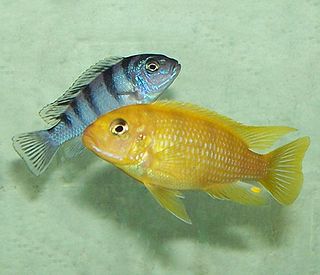
Maylandia lombardoi, is a 13 centimetres (5.1 in) long freshwater fish from the family Cichlidae. This species is popular in the aquarium hobby where it is sold under a variety of common names including: lombardoi mbuna, kenyi mbuna or kennyi mbuna or kenyi cichlid. This species is sometimes seen in the genus Metriaclima owing to a dispute in which a minority of cichlid researchers do not consider Maylandia valid (see Maylandia for discussion. The specific name honours the exotic fish dealer John Lombardo.

Mayaheros urophthalmus, also known as the Mayan cichlid or Mexican mojarra is a species of cichlid.

Anomalochromis is a genus of fish in the family Cichlidae, containing the single species Anomalochromis thomasi, the African butterfly cichlid. It is a small cichlid growing to a length of 6–8 centimetres (2.4–3.1 in). The natural habitat of A. thomasi is Sierra Leone, Liberia and Guinea, mainly in smaller streams. The fish are typically found in slightly acidic, oxygen rich water with other west African cichlid genera such as Hemichromis and Pelvicachromis.
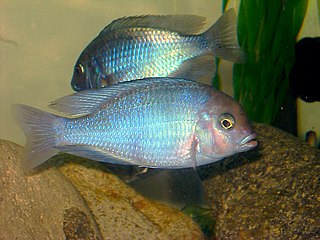
Cyrtocara moorii, commonly known as the hump-head, is a species of haplochromine cichlid endemic to Lake Malawi in east Africa where they prefer areas with sandy substrates. It can grow to a length of 20 centimetres (7.9 in) TL. The species is popular among aquarium keepers where it is known as the hump-head cichlid, blue dolphin cichlid, Malawi dolphin or simply as moorii. It is currently the only known member of its genus. The specific name honours the English cytologist and biologist John Edmund Sharrock Moore (1870-1947).

Iodotropheus sprengerae, the rusty cichlid, lavender mbuna or lavender cichlid, is a species of cichlid endemic to the Boadzulu and Chinyankwazi Islands and Chinyamwezi Island regions of Lake Malawi. It prefers a temperature range of 24-26 °C.

The spotted tilapia, also known as the spotted mangrove cichlid or black mangrove cichlid, is a species of fish of the cichlid family. It is native to fresh and brackish water in West and Central Africa, but has been introduced to other regions where it is considered invasive.
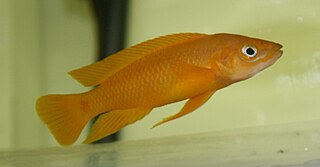
Neolamprologus leleupi is a species of cichlid endemic to Lake Tanganyika where it occurs throughout the lake. It is a recess-dweller, inhabiting cracks and crevices. It feeds on invertebrates living in the rich biocover of the substrate. This species reaches a length of 10 centimetres (3.9 in) TL. The color of this fish ranges from bright yellow to deep brown. Both color variations exist at each location where this species is found. This relatively small cichlid is a substrate spawner. It is easily confused with the very similar N. longior a fish also endemic to Lake Tanganyika. The specific name honours the Belgian entomologist Narcisse Leleup (1912-2001), who collected the type.

Copadichromis borleyi is a species of haplochromine cichlid fish endemic to Lake Malawi in East Africa. The species is popular in the fishkeeping hobby where it is frequently kept in aquariums. The species has numerous common names, including redfin and goldfin hap.

Pseudotropheus johannii or the bluegray mbuna is an African freshwater fish from the family Cichlidae.
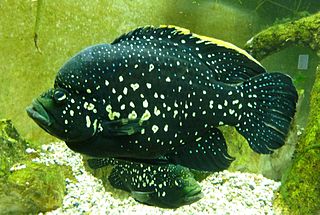
Paratilapia polleni is a medium-sized cichlid endemic to Madagascar. It is also a popular fish for display at public aquaria.

The giant cichlid, also known as the emperor cichlid, is a species of fish in the family Cichlidae, endemic to Lake Tanganyika in Africa. It is the only member of its genus Boulengerochromis and tribe Boulengerochromini.
Astatotilapia flaviijosephi, the Jordan mouthbrooder, is a vulnerable species of freshwater fish in the family Cichlidae (cichlids). It is found in the central Jordan River system, including Lake Tiberias (Kinneret), in Israel, Jordan and Syria, making it the only haplochromine cichlid to naturally range outside of Africa. This species is too small to be of significant importance to fisheries, unlike the only other cichlids native to the Levant, the economically important tilapias.

Julidochromis dickfeldi is a species of cichlid endemic to Lake Tanganyika in Africa where it is only known from the southwestern portion. This species inhabits areas with rock/rubble substrates, each fish maintaining a territory around a crevice or crack. This species reaches a length of 11 centimetres (4.3 in) TL.
The threadfin cichlid is a species of cichlid endemic to Lake Tanganyika found in areas with rocky substrates on which it can graze on algae. This species can reach a length of 18 cm (7.1 in). It can be found in the aquarium trade. The specific name of this cichlid honours the British ichthyologist Ethelwynn Trewavas (1900-1993).

Chindongo demasoni is a species of cichlid endemic to Lake Malawi where it is only known from the Pombo Rocks in Tanzanian waters. This species can potentially reach a maximum length of 10 centimetres (3.9 in) SL. It is now commonly found in the aquarium trade.

Pseudotropheus saulosi is a species of cichlid endemic to Lake Malawi in East Africa, where it lives in areas with rocky substrates. It is classified as a dwarf-mbuna and was first described by Ad Konings in 1990, who gave it the specific name saulosi in honour of Saulos Mwale who caught over 3,000 specimens in a single day on the expedition which collected the type. It comes from an area of the lake called Taiwan Reef, and from nowhere else. This fish can also be found in the aquarium trade.
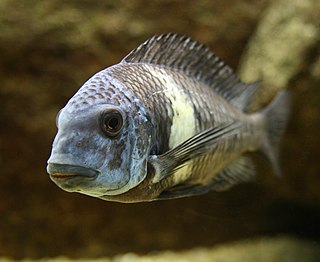
Tropheus duboisi, the white spotted cichlid, is a species of cichlid endemic to Lake Tanganyika. It can reach a length of 12 cm (4.7 in).

Tilapia sparrmanii, the banded tilapia, or vlei kurper, is a widespread and adaptable cichlid fish that is found in warmer freshwater habitats of southern Africa. They prefer water with ample plant cover, and occur naturally as far north as DR Congo and Tanzania. They have been introduced locally in the northern hemisphere. Younger banded tilapia feed on crustaceans and insect larvae, while the adults feed on terrestrial and aquatic plants and other debris. They undertake local migrations and may shoal before and during spawning time. They guard their own eggs, and although they may move eggs or fry in the mouth, they are not known to be actual mouthbrooders like several other tilapia species. This species can reach a length of 23.5 centimetres (9.3 in) TL and is an important foodfish.

The blackchin tilapia, formerly Tilapia melanotheron, T. heudelotii and T. leonensis, is a species of cichlid native to coastal west Africa. It is a paternal mouthbrooder which has been introduced to Asia and North America.



















